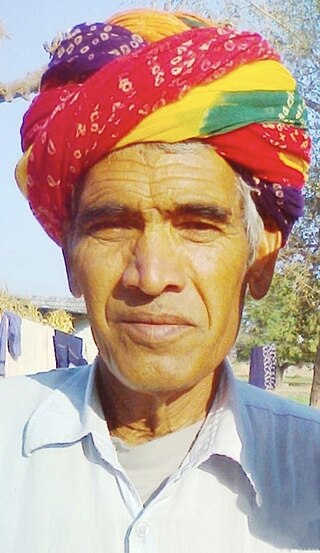
A turban is a type of headwear based on cloth winding. Featuring many variations, it is worn as customary headwear by people of various cultures. Communities with prominent turban-wearing traditions can be found in the Indian subcontinent, Southeast Asia, the Middle East, the Balkans, the Caucasus, Central Asia, North Africa, West Africa, East Africa, and amongst some Turkic peoples in Russia.
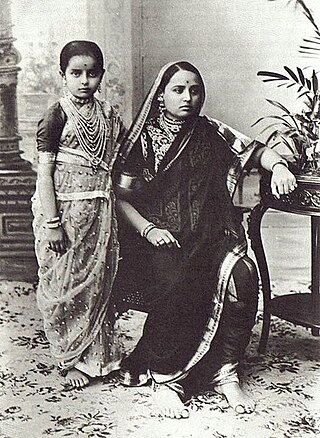
A sari is a women's garment from the Indian subcontinent, that consists of an un-stitched stretch of woven fabric arranged over the body as a robe, with one end attached to the waist, while the other end rests over one shoulder as a stole (shawl), sometimes baring a part of the midriff. It may vary from 4.1 to 8.2 metres in length, and 60 to 120 centimetres in breadth, and is form of ethnic wear in India, Sri Lanka, Nepal, Bangladesh and Pakistan. There are various names and styles of sari manufacture and draping, the most common being the Nivi style. The sari is worn with a fitted bodice also called a choli and a petticoat called ghagra, parkar, or ul-pavadai. It remains fashionable in the Indian subcontinent today.
Ikat is a dyeing technique from Indonesia used to pattern textiles that employs resist dyeing on the yarns prior to dyeing and weaving the fabric. The term is also used to refer to related and unrelated traditions in other cultures. In Southeast Asia, where it is the most widespread, ikat weaving traditions can be divided into two general clades. The first is found among Daic-speaking peoples. The second, larger group is found among the Austronesian peoples and spread via the Austronesian expansion. Similar dyeing and weaving techniques that developed independently are also present in other regions of the world, including India, Central Asia, Japan, Africa, and the Americas.

A sarong or a sarung is a large tube or length of fabric, often wrapped around the waist, worn in Southeast Asia, South Asia, Western Asia, Northern Africa, East Africa, West Africa, and on many Pacific islands. The fabric often has woven plaid or checkered patterns, or may be brightly colored by means of batik or ikat dyeing. Many modern sarongs have printed designs, often depicting animals or plants. Different types of sarongs are worn in different places in the world, notably the lungi in the Indian subcontinent and the izaar in the Arabian Peninsula.
Clothing in India varies with the different ethnicities, geography, climate, and cultural traditions of the people of each region of India. Historically, clothing has evolved from simple garments like kaupina, langota, achkan, lungi, sari, to rituals and dance performances. In urban areas, western clothing is common and uniformly worn by people of all social levels. India also has a great diversity in terms of weaves, fibers, colors, and the material of clothing. Sometimes, color codes are followed in clothing based on the religion and ritual concerned. The clothing in India also encompasses a wide variety of Indian embroidery, prints, handwork, embellishments, and styles of wearing clothes. A wide mix of Indian traditional clothing and western styles can be seen in India.

The malong is a traditional Filipino-Bangsamoro rectangular or tube-like wraparound skirt bearing a variety of geometric or okir designs. The malong is traditionally used as a garment by both men and women of the numerous ethnic groups in the mainland Mindanao and parts of the Sulu Archipelago. They are wrapped around at waist or chest-height and secured by tucked ends, with belts of braided material or other pieces of cloth, or are knotted over one shoulder. They were traditionally hand-woven, with the patterns usually distinctive to a particular ethnic group. However, modern malong are usually machine-made or even imported, with patterns that mimic the traditional local designs.

A lavalava, sometime written as lava-lava, also known as an 'ie, short for 'ie lavalava, is an article of daily clothing traditionally worn by Polynesians and other Oceanic peoples. It consists of a single rectangular cloth worn similarly to a wraparound skirt or kilt. The term lavalava is both singular and plural in the Samoan language.

Tupenu is the Tongan term for a wrapped garment also called a sarong, lungi, or lava-lava, worn through much of South Asia, Southeast Asia, Arabian peninsula, the Horn of Africa and Oceania. It is analogous to the kilt worn in Scotland.
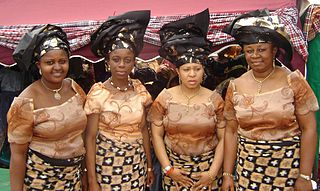
The wrapper, lappa, or pagne is a colorful garment widely worn in West Africa by both men and women. It has formal and informal versions and varies from simple draped clothing to fully tailored ensembles. The formality of the wrapper depends on the fabric used to create or design it.
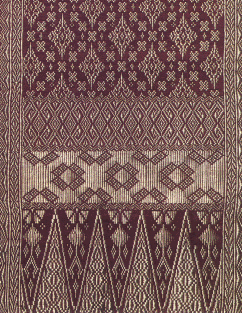
Songket or sungkit is a tenun fabric that belongs to the brocade family of textiles of Brunei, Indonesia, Malaysia, and Singapore. It is hand-woven in silk or cotton, and intricately patterned with gold or silver threads. The metallic threads stand out against the background cloth to create a shimmering effect. In the weaving process the metallic threads are inserted in between the silk or cotton weft (latitudinal) threads in a technique called supplementary weft weaving technique.
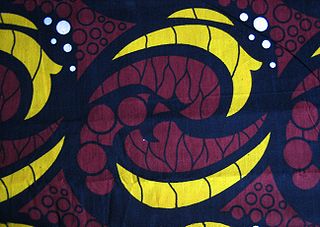
A kitenge or chitenge is an East African, West African and Central African piece of fabric similar to a sarong, often worn by women and wrapped around the chest or waist, over the head as a headscarf, or as a baby sling. Kitenges are made of colorful fabric that contains a variety of patterns and designs. In coastal areas of Kenya and in Tanzania, kitenges often have Swahili sayings written on them. There seems to be a confusion with the Kangas, which indeed carry texts in contrast with kitenges, which apparently typically do not carry texts.
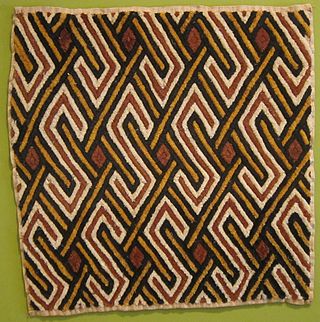
African textiles are textiles from various locations across the African continent. Across Africa, there are many distinctive styles, techniques, dyeing methods, and decorative and functional purposes. These textiles hold cultural significance and also have significance as historical documents of African design.

Pakaian is the term for clothing in Malaysia's national language. It is referring to things to wear such as shirts, pants, shoes etc. Since Malaysia is a multicultural nation: Malay, Chinese, Indian and hundreds of other indigenous groups of Malay Peninsula and Borneo, each has its own traditional and religious articles of clothing all of which are gender-specific and may be adapted to local influences and conditions. Previously, traditional clothes were worn daily. However, by excluding Baju Melayu, Baju Kurung many are now only worn on special occasions such as marriage ceremonies and cultural events.

Outside Western cultures, men's clothing commonly includes skirts and skirt-like garments; however, in the Americas and much of Europe, skirts are usually seen as feminine clothing and socially stigmatized for men and boys to wear, despite having done so for centuries. While there are exceptions, most notably the cassock and the kilt, these are not really considered 'skirts' in the typical sense of fashion wear; rather they are worn as cultural and vocational garments. People have variously attempted to promote the fashionable wearing of skirts by men in Western culture and to do away with this gender distinction.

Khmer traditional clothing refers to the traditional styles of dress worn by the Khmer people from ancient times to the present.
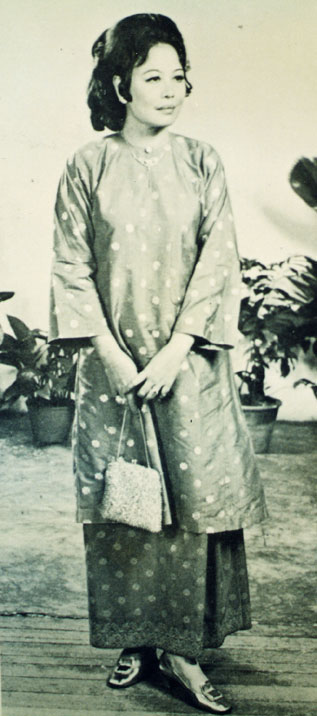
Baju Kurung is a traditional attire of Malays and traditionally worn by women in Brunei, Indonesia, Malaysia, Singapore and southern Thailand. This type of traditional attire is the national dress of Brunei and Malaysia. In Indonesia, this dress is also worn as a regional attire, commonly observed on the island of Sumatra, particularly by the ethnic Malay and Minangkabau women.

Tnalak, is a weaving tradition of the Tboli people of South Cotabato, Philippines. T'nalak cloth is woven exclusively by women who have received the designs for the weave in their dreams, which they believe are a gift from Fu Dalu, the T'boli Goddess of abacá.

The national costume of Indonesia is the national attire that represents the Republic of Indonesia. It is derived from Indonesian culture and Indonesian traditional textile traditions. Today the most widely recognized Indonesian national attires include batik and kebaya, although originally those attires mainly belong within the island of Java and Bali, most prominently within Javanese, Sundanese and Balinese culture. Since Java has been the political and population center of Indonesia, folk attire from the island has become elevated into national status.

Balinese textiles are reflective of the historical traditions of Bali, Indonesia. Bali has been historically linked to the major courts of Java before the 10th century; and following the defeat of the Majapahit kingdom, many of the Javanese aristocracy fled to Bali and the traditions were continued. Bali therefore may be seen as a repository not only of its own arts but those of Java in the pre-Islamic 15th century. Any attempt to definitively describe Balinese textiles and their use is doomed to be incomplete. The use of textile is a living tradition and so is in constant change. It will also vary from one district to another. For the most part old cloth are not venerated for their age. New is much better. In the tropics cloth rapidly deteriorates and so virtue is generated by replacing them.
Clothing in Myanmar varies depending on the ethnicity, geography, climate and cultural traditions of the people of each region of Myanmar (Burma). The most widely recognized Burmese national costume is the longyi, which is worn by both males and females nationwide. Burmese clothing also features great diversity in terms of textiles, weaves, fibers, colours and materials, including velvet, silk, lace, muslin, and cotton.

















